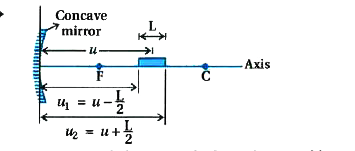Will the focal length of a lens for red light be more, sam or less than that for blue light Solution in Gujrati
If focal length of a given lens is f in air the accoding to lens maker formula,
1f=(μ−1)[1R1−1R2]
∴1f∝(μ−1)
(∵ remaining terms remain constans
⇒ We know that μb>ur and so fb<fr
Thus, focal length of a given lens is smaller for blue light as compared to red light.
Topper's Solved these Questions
- RAY OPTICS AND OPTICAL INSTRUMENTSBook:KUMAR PRAKASHANChapter:RAY OPTICS AND OPTICAL INSTRUMENTSExercise:SECTION-C (NCERT EXEMPLAR SOLUTION) (SHORT ANSWER TYPE QUESITONS)
Explore 6 Videos
- RAY OPTICS AND OPTICAL INSTRUMENTSBook:KUMAR PRAKASHANChapter:RAY OPTICS AND OPTICAL INSTRUMENTSExercise:SECTION-C (NCERT EXEMPLAR SOLUTION) (LONG ANSWER TYPE QUESITONS)
Explore 5 Videos
- RAY OPTICS AND OPTICAL INSTRUMENTSBook:KUMAR PRAKASHANChapter:RAY OPTICS AND OPTICAL INSTRUMENTSExercise:SECTION-C (NCERT EXEMPLAR SOLUTION) (MULTIPLE CHOICE QUESTIONS (MCQs))
Explore 16 Videos
- MOVING CHARGES AND MAGNETISMBook:KUMAR PRAKASHANChapter:MOVING CHARGES AND MAGNETISMExercise:SECTION D (MCQs ASKED IN COMPETITIVE EXAMS)
Explore 34 Videos
- SAMPLE QUESTION PAPER Book:KUMAR PRAKASHANChapter:SAMPLE QUESTION PAPER Exercise:PART-B SECTION-C
Explore 5 Videos
Similar Questions
A short object of length L is placed along the principal axis of a concave mirror away from focus. The object distance is u. If the mirror has a focal length f, what will be the length of the image ? You may take L<<|v−f|.

View SolutionShow that for a material with refractive index μ≥√2~ , light incident at any angle shall be guided along a length perpendicular to the incident face.
View SolutionA ray of light incident at an angle θ on a refracting face of a prism emerges from the other face normally. If the angle of the prism is 5∘ and the prism is made of a material of refractive index 1.5, the angle of incidence is
View SolutionElectric charge Q having mass M moves on a circular path of radius R with velocity →v, perpendicular to uniform magnetic field B. When a particle completes one revolution, work done by the field is _______
View SolutionTwo charges –q and +q are located at points (0, 0, –a) and (0, 0, a), respectively.
(a) What is the electrostatic potential at the points (0, 0, z) and (x, y, 0) ?
(b) Obtain the dependence of potential on the distance r of a point from the origin when r/a>>1 .
(c) How much work is done in moving a small test charge from the point (5,0,0) to (–7,0,0) along the x-axis? Does the answer change if the path of the test charge between the same points is not along the x-axis?
View SolutionWill the focal length of a lens for red light be more, same or less than that for blue light ?
View SolutionfB and fR are focal lengths of a convex lens for blue and red light respectively and F_(B_ and Fr are the focal lengths of the concave lens for blue and red light respectively. We must then have
View SolutionWhen monochromatic red light is used instead of blue light in a convec lens, its focal length will :
View SolutionWhen red light passing through a convex lens is replaced by light of blue colour, how will the focal length of the lens change ?
View SolutionWill a lens focus for red light be more than its focus for blue light, will it be the same, or will it be less?
View SolutionWill the focal length of a lens for red light be more, same or less than that for blue light ?
View SolutionWill the focal length of a lens for red light be more, same or less than that for blue light ?
View SolutionA: When white light passes through lens then refraction of violet light is more than that of red light.
R: For given lens, focal length of red light is more than that of violet light.
View SolutionHow does the focal length of a glass lens change when blue light is replaced by red light. Give reasons.
View Solution(A) The focal length of lens changes when red light is replaced by blue light
( R) The focal length of lens does not depend on colour of light speed.
View Solution
